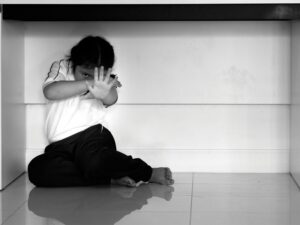
Active-Shooter Drills At School
“Mommy, all of my friends at school don’t fit in the closet in our classroom.”
Kate said this as such an offhand comment that I almost missed it. When I asked why everyone was trying to fit into the closet, the answer occurred to me even as she was explaining.
“In case a bad guy comes to our school and wants to hurt us.”
Emotions hit me like waves. I was angry that my innocent little five year old had to practice smushing into a closet at what is supposed to be a safe place for kids, her kindergarten classroom. Then, I was upset that the school had not communicated this drill to the parents so that I could have prepared her in my own way. Then, I was grateful for the school and teachers who would risk everything to save the children in their care.
According to the World Health Organization (WHO), one billion children worldwide will face violence this year. The WHO document, School-Based Violence Prevention, identifies schools as a leading environment for conducting violence prevention efforts.
Why are these drills important?
Do you know how many school shootings have occurred so far this year? I didn’t. As of this publication, there have been 14 school shootings with injuries or deaths in 2019, according to Education Week. In 2018, there were 24 school shootings which resulted in 79 people being injured and the death of 35.
“Hearing about school shootings is so common now. I’m not sure if kids are just desensitized to it,” comments local high school teacher Scarlett T. “It’s interesting that government buildings and airports are often more protected than where our kids are every day. As a teacher, I am keenly aware that it could also happen to us. It’s something teachers definitely think about.”
Teachers do struggle with the realities of today’s classrooms. Emily Z. shares, “Wording is very carefully chosen. It’s a calm setting where we practice in the classroom as a lockdown drill.” She also shares her fears. “People tend to not realize or notice or know that today’s classrooms are jam packed, 34 kids, sometimes more. I’d take a bullet for any child, any time, any school, and without a moment’s hesitation. That’s not the part I struggle with…that’s the easy part.
“Today’s classrooms are much fuller than in the past, and that is a huge responsibility on one person for all of those tiny lives. En Loco Parentis is a Latin phrase I learned early on in college. It means ‘in place of the parent.’ During each school day, I am expected to care for children with the amount of love and effort that any mother would show her child. That’s a lot when you realize that 34 students are in there! It’s a huge commitment, but the absolute most rewarding job, so I wanted to make sure I was doing all that I could,” she says. Emily then went on to explain that she went and got additional training to empower herself to empower and protect her students.
What are our kids experiencing?
There are so many factors that affect how students are impacted by practicing active-school shooter drills. Mental health counselor Tara Dixon shares, “Students come to school with a variety of experiences that may affect how they perceive these drills. Students who come from a violent home or community environment may respond differently than a student who feels safe in his or her home. Active-shooter school drills may serve to heighten some students’ fears and anxieties, but they also may help other students to feel empowered that there is a plan.”
Local mom Chelsey R. mirrors Dixon’s comments, “When I look at it through my autistic son’s eyes, I feel it’s both. He already has extreme fear and anxiety about many things and being harmed at school is one. However, he has also made comments numerous times about how grateful he is to know how to handle a situation, like a shooting, should he be placed in that situation.”
I happened to be in a PreK classroom when the announcement came over the loudspeaker that the school was in active lockdown. The teacher sprang to action, directing her four year olds to go quickly under her desk and sit down, reminding them that she was going to turn off the lights. She didn’t have to lock the door because it is standard protocol to keep classroom doors locked at all times at her school already. She turned off the lights and the room was plunged into absolute darkness. Several students were afraid of the dark and started to cry and ask for the lights to be turned back on. The teacher whispered to the children to be very quiet, like when they play hide and seek, but for some little ones, the fear of the darkness was too much.
“When talking to my students about our class emergency plan, and even when practicing, they don’t seem overly phased, not even my first graders,” shares teacher Haley N. “I tried to say we were practicing in case there was a stranger on campus once, and one of my first-graders very matter of factly announced to the class, ‘Yep, cause if there’s a stranger, he might have a gun and then he will shoot us and we all will die.’ Then, the rest of the class chimed in with, ‘Yeah, that’s right,’ ‘He might shoot everyone,’ ‘Mrs. N. would kill him first,’ and ‘He would think we are at P.E. cause we hide so well!’ It was just a regular morning conversation to them. It’s horrible that this is our children’s normal now.”
Teacher Hanna B. reports split emotions in her fourth grade classroom. “It is a good thing to practice, so that the kids know what to expect if something were to happen. But, it freaks some of them out since it feels real to them.”
Older students often have much more of a sense of understanding about active-shooter drills. Scarlett T. shares, “I think some students feel like we are sitting ducks. They think we should run.” At her school, the protocol is to lock the doors, cover the windows, and stay down. “But, some students don’t seem to think about the drills as much.”
High school teacher and mom, Layla D., shares, “I think students’ reactions to active shooter drills have changed drastically during my time as a teacher. When we first started performing these drills early in my career, the students took them much more seriously. Some were even anxious and asked many questions about the proper way to behave in these scenarios. However, now the students have a more blasé attitude toward the drill.” Lauren, Layla’s teen daughter adds, “I feel like they are a very necessary drill to have because of the increase in school shootings in the past few years. It may scare some students and some may not take the drills seriously, but I think it is a very important way to help prevent deaths if this situation were to actually occur.”
Is there school and teacher training?
The teacher’s demeanor and level of training for such drills, as well as the age of the students, make a huge difference in how the drill is perceived.
In the WHO School-Based Violence Prevention handbook, the following are listed as criteria for developing a violence prevention curriculum: keep materials and information age-appropriate, use active participation to help students learn the material, use capable and motivated teachers who have been well trained, review the curriculum often with feedback from students and teachers, and work to ensure that the materials used are culturally relevant.
Some local schools use code phrases to indicate the start of an active-school shooter drill, while others announce, “We are in active lockdown. Please follow all lockdown procedures.” Some teachers are trained in the exact protocol, while others seem as in the dark as the students at times. Local elementary teacher, Lindsay H., shares, “We never practiced active-shooter drills. Our ‘plan’ was to run, if possible, or huddle up behind desks away from the windows.”
How can parents help?
Many teachers want parents to know that they are an important part of practicing for school emergencies and preparing their children emotionally for what might be practiced at school.
Local teacher Timothy C. shares, “Parents should speak with their young children about it before they release their children into the care of others. As a teacher, if it is my job to protect your child with my own life, and they do not understand their own role is survival, then it is my job to educate them so that we all have a better chance of surviving. Bad dreams are scary but not real, but drive-by and school shootings are real. Please speak with your child first if you do not want him or her learning about it first at school.”
Talk to your child’s school about the drills that your child will practice, then talk to your child. Start the conversation with open-ended questions such as, “How did it make you feel to practice getting under the desks?” Validate your child’s feelings and avoid the temptation to brush off his or her's fears and concerns. Ask your child what questions he or she might have about the drills at school and answer the questions in an honest, age appropriate way. Remind your child that he or she can come to you with additional questions or concerns at any time.
If your child seems withdrawn, anxious, or fearful of school or school-related events; begins having school-related nightmares; or you notice changes in your child’s academic performance or friends he or she spends time with, consider reaching out to a local mental health professional.
Providing your child with information can help to alleviate his or her fears regarding these drills, and also give you, as a parent, some peace of mind, too. ■





